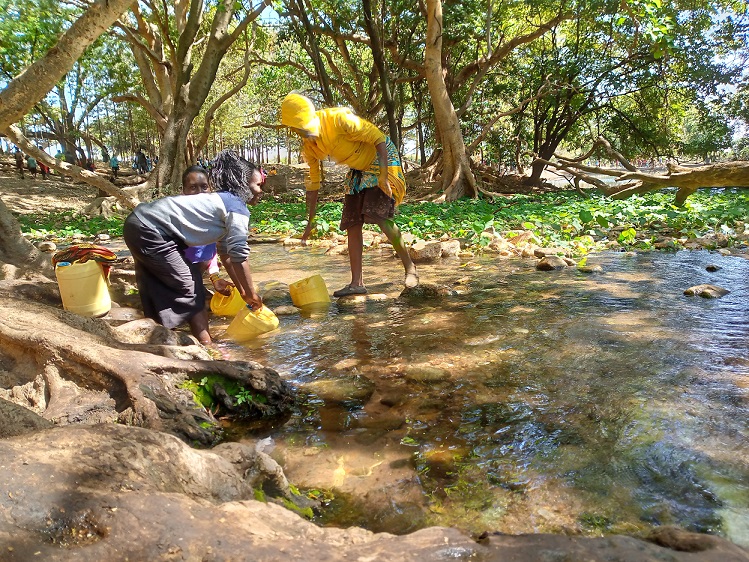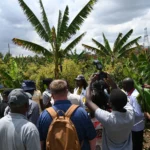
By Clifford Akumu
On the fringe of Naroosura village, several kilometres South of Narok, Patrick Tolo walks in his black sandals made from old tires and a traditional herding stick in his hand on smooth rocks that seem to form a pattern.
Behind him are pastoralists crisscrossing the patched land with their livestock in search of pasture, the goats occasionally munching young fresh acacia leaves. Women can also be seen with jerrycans full of water on their backs and others rolling on the ground.
Mr Tolo is on his way to Enkong’u Enkare water spring (locally known as the eye of water) – a critical fresh water source that sustains the lives and livelihoods of thousands of residents.
Tolo, 51, recalls how the community has been dealing with human-wildlife conflict at the water spring due to prolonged drought. The water level has drastically reduced.
“Many have fallen victims to the wild animals, especially elephants roaming the area in search of food and water. The elephants cleared my sugarcane and banana plantation. I no longer grow them. I have decided to grow fast maturing crops like tomatoes and vegetables,” says Mr Tolo, as he inspects the pipes that he uses to irrigate an adjacent land.
For Sayianka Nkiminis, memories of an encounter with a male buffalo that was destroying his maize are painful. The animal nearly killed him. “The animal charged at me. The only thing I can remember is being airborne, having been lifted by the animal’s horns, before a fall with a thud. One of the horns got lodged between my legs and it nearly mutilated my genitals,” he recalls.
nearby villagers save his life. He lay in a coma at the Narok County Referral Hospital for three days.
“I’m lucky to have made it alive,” Nkiminis says.
-diverse ecosystems on the planet and can only be compared to rainforest and coral reefs. They reduce the likelihood of flooding by soaking up excess water from swollen rivers. They filter pollutants from groundwater before it enters aquifers, and are one of the most effective natural carbon storage systems on the planet.
According to the Ramsar Scientific and Technical Review Panel, wetlands store 35 per cent of the world’s land-based carbon, despite covering just 9 per cent of its surface.
Enkong’u Enkare water catchment has two springs. The cold one diverts to Ntuka Sub-location, supporting four schools and domestic use, while the warm one flows down and becomes the Naroosura river.
Olchoro Ngussur and Olmaisuri Entiapiri wetlands are in Narok South.
WWF programmes Coordinator for Mau-Mara-Loita region Kevin Gichangi says wetlands destruction increases vulnerability to extreme climate change effects, including flooding and drought.
“Enkong’u Enkare is a perennial spring that serves the community and supplies vital habitat and “biological supermarkets” for wildlife,” he says.
few kilometres away, the Embukitaa Hills, the breeding site for elephants, protrude.
r Gichangi says many aquatic species are endangered when wetlands are degraded. “Apart from aquatic species that depend directly on the wetland, it is also a source of water for rivers that sustain wildlife downstream. This spring lies in the Mara Ecosystem that is well known for wildlife,” he says, warning that the rate at which wetlands are being degraded will be detrimental to the country.
90 per cent of the wetlands have been degraded since the 1700s.We are losing wetlands three times faster than we are losing forests” adds Mr Gichangi.
According to the January 2023 National Drought Early Warning bulletin produced by the National Drought Management Authority, Narok County is in the alert drought phase.
The bulletin reveals that the drought situation is critical in 22 of the 23 ASAL counties due to the late onset and poor performance of the much-anticipated October to December 2022 short rains, coupled with previous consecutive failed rainfall seasons.
Preserved by the Ministry of Irrigation in 1982 to provide water for domestic use, Enkong’u Enkare spring remains a critical wetland supporting more than 15,000 people with its more than 29 million cubic metres, as per the records from the Ministry of Water.
Encroachment by humans and wildlife almost risked the water source becoming just another afterthought in a story about restoration. Two years ago the spring was also threatened by siltation and other pollutants flowing into the water pan built to collect the spring’s water. Erratic weather patterns, a perennial drought and sporadic flooding saw the mini dam’s bed filled with harmful waste and silt.
“It was full of silt, which used to fill the whole dam. The dam had also been invaded by water hyacinth,” says Mr Tolo, who grows vegetables, maize and beans nearby.
The WWF Kenya began a rehabilitation project on the dam, removing the silt that had clogged it. It also built several canals to supply directly from the spring to several farms and projects, including Naroosura and Oloiboroing’oni irrigation schemes under the water resource users association.
It also repaired the cattle trough and the communal water points, planting indigenous trees and repairing the fence to keep off wild animals. The farmers grows mainly fast-maturing horticulture crops such as tomatoes, cabbages, onions, beans and maize.
“Were it not for this water, people wouldn’t have lived here because the place is so dry. It had a lot of trees and that is why it is called Naroosura (the green forest),” says James ole Tago, the Naroosura Water Resource Users Association secretary, that ensures the natural resource is protected.
And because of these multi-water uses, the spring needs more protection than any other wetland,” he says.
The WRUA was created to train the community on sustainable farming and come up with water use schedules to avoid water-related conflicts locally.
During dry season, when the water volumes at the spring reduce, Naroosura WRUA advises farmers to farm on small portions of the land to enhance uniform allocation of water in each plot.
water my crops twice in a week, according to the schedule by the Naroosura WRUA. The farmers group has also drawn a timetable on members that are tasked to oversee the process,” says Tolo.
“We are now able to pump water to irrigate crops. I harvest between eight and 10 bags of maize,” he says.
The irrigation project targeted integrated water resource management through sustainable farming practices. It trained the farmers on how to avoid water pollution by not emptying chemicals and farm waste in the river system to keep river Naroosura clean for downstream users not to get water-borne diseases.
“We also trained the farmers on integrated pest management and how to do organic farming,” explains Mr Tago.
told the government to second an expert to the catchment to determine the extent of the water table to avoid further destruction. “We need an expert who understands the extent of the water table so that we can protect it,” says Bishop Simon Shimpai, the Naroosura WRUA chairman.
Forestry and Climate Change CS Soipan Tuya says awareness creation on the impact of wetland restoration among community members is vital. “We hope the local communities can take measures to improve government adaptation and mitigation of climate change. Wetland restoration is one such activity,” the CS said during this year’s World Wetlands Day at Enkong’u Enkare, whose theme was “Wetlands Restoration”.
urrently, Narok County has 14.01 percent forest cover and 20 percent tree cover. It still has 300,000ha available for restoration over the next 10 years to meet the 30 percent tree cover as set out by the President.
oipan said her government will establish a “green army” within Nark County to help increase these numbers and sustain the 15 billion trees agenda until maturity.
arok Governor Patrick ole Ntutu has reiterated that his government will identify and restore the natural springs in Narok to mitigate effects of drought. While climate change poses a serious threat to the existing wetlands, our grazing and animals husbandry nature continue to pose an even bigger challenge to our conversation efforts,” said Mr Ntutu.
Overstocking in the conservancies and outside the Masai Mara Natural Reserve has disrupted the flow of the Mara River and shortened the cycle of high and low peak in the flow of the river from 90 to just 16 days during the rainy season,” he added.
tutu urged the national government to put stringent measures to tame encroachment of riparian lands to conserve and preserve the environment.








